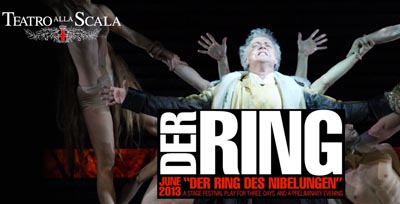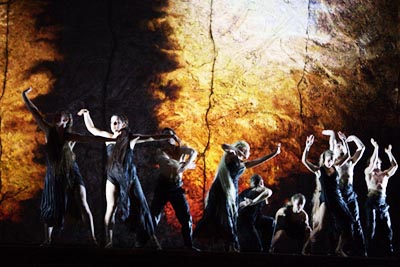 Der Ring des Nibelungen—affectionately known to English-speakers as “the Ring,” is not only a transcendent marathon of four very long operas, but arguably one of the artistic masterworks of Western civilization. Hence, I can be forgiven for having saved up a chunk of change, flown to Milan two weeks ago and spent eight days in the fashion capital of the known world gearing up for a memorable musical experience. After feasting my eyes on gorgeous people (okay, men), imbibing my fair share of an alluring crimson liquid known as Campari, and sampling a few choice pastas—I made time to dress up, strap on some high heels and click, click, click my way across the cobblestones to Teatro alla Scala (two blocks from my hotel). There I joined smartly-dressed pilgrims from all over the globe for four nights of ravishing opera conducted by Daniel Barenboim and written 150 years ago by the controversial genius Richard Wagner.
Der Ring des Nibelungen—affectionately known to English-speakers as “the Ring,” is not only a transcendent marathon of four very long operas, but arguably one of the artistic masterworks of Western civilization. Hence, I can be forgiven for having saved up a chunk of change, flown to Milan two weeks ago and spent eight days in the fashion capital of the known world gearing up for a memorable musical experience. After feasting my eyes on gorgeous people (okay, men), imbibing my fair share of an alluring crimson liquid known as Campari, and sampling a few choice pastas—I made time to dress up, strap on some high heels and click, click, click my way across the cobblestones to Teatro alla Scala (two blocks from my hotel). There I joined smartly-dressed pilgrims from all over the globe for four nights of ravishing opera conducted by Daniel Barenboim and written 150 years ago by the controversial genius Richard Wagner.
Wagner did not disappoint. He simply cannot. Barenboim was not only superb in guiding a super-sized orchestra through 21 hours of difficult music, but his expansive phrasing—each opera ran at least 15 minutes longer than any versions I’d heard before—coaxed nuance upon nuance, and deepened meanings at every possible chromatic juncture. The master and his interpreter were without question the stars of La Scala’s 2013 production. So now I can remove the gloves.
High on the possibilities of digital special effects, postmodern visual concept and staging overkill, the Ring’s director Guy Cassiers almost ruined  every instance of set decor and scene transition in the entire four night’s production. The first of two complete “Ring” cycles at La Scala, this visually absurd production—with ludicrous costumes by Tim van Steenburgen—had been performed last April in Berlin. What were they thinking?! (You can get some idea from this shot from Rheingold).
every instance of set decor and scene transition in the entire four night’s production. The first of two complete “Ring” cycles at La Scala, this visually absurd production—with ludicrous costumes by Tim van Steenburgen—had been performed last April in Berlin. What were they thinking?! (You can get some idea from this shot from Rheingold).
Yes, Christina, but how were the singers? Good and bad, but mostly quite up to the task, especially the very broad-shouldered Irene Theorin as Brunnhilde, Johannes Martin Kränzle as Alberich, and Waltraude Meier as Sieglinde. We heard two Wotans, each fine, nothing rich and memorable. And of our two Siegfrieds, only the stalwart Andreas Schager proved convincing.
As the Siegfried of the third opera, Siegfried, American tenor Lance Ryan looked terrific in his long hair and leather jacket, but alas his high notes each expanded into an endless vibrato wide enough to drive a jumbo jet through. Ack! Where are the Lauritz Melchiors of yore?
Back to the visually hopeless production itself. Milan is a tasteful city, and La Scala is an opulent yet tastefully opulent setting for grand opera. Belgian Guy Cassiers came to town with a bag of neon-hued pixels and proceeded to unload them all over the stage, the singers, the backdrops, the clunky “trees,” the long rows of boxes that stood in for rocks, caves, villages, whatever was needed. These tiers of boxes—which someone thought would make for clever, multi-storied platforms upon which to sing, kiss, pose, whatever—actually made noise as they moved into position during the opera. Long moments of metallic scratching threatened the ravishing music, and at one scene change during the final opera, Die Gotterdammerung, the audience actually heard yelling from behind the scrims as stage hands negotiated for what was supposed to go where.
One of the biggest issues with Cassiers’ production: e.g. digital overkill, which meant that we were treated to one, two, three, sometimes more giant backdrop panels upon which digital abstractions moved, flowed, twitched, and morphed as singers attempted to salvage Wagner’s mythic spell. Why did the red digital patterns turn to green and then back to red as the frenzied squiggles swept over the singer’s bodies, floor, and everything in between? There was so much light and color frenzy without any narrative rationale that I felt like I was watching outtakes from Burning Man that had been modified for an Armani-clad audience clad audience.
Worse (oh God and this was the real mood-killer) Cassiers wasn’t quite confident that Wagner—his music, his words, and the singers—could actually tell the interwoven stories of the Ring. So just to make sure we could follow the action, he threw in a handful of dancer/mimes who during three of the operas actually danced, twirled and pranced the “meaning” of the various scenes. When the Rhine Maidens reject Alberich, we get an amateur dance troupe (seriously, it was like a cross between the Renaissance Fair and a Pride Day parade) dancing the Rhine Maidens as they reject Alberich. Their hands, arms, legs, and torsoes simply would not stop writhing and twitching. “No, no Alberich,” they pantomimed, “we do not want to sleep with you.” Truly wretchedly amateurish movements, and incessant, in-your-face fluttering—they simply would not stop!! Only Siegfried was mercifully free of live dancers on stage, though we did have to endure an irritating digital display of the dancers’ bodies turned into a Rorschach that mimicked the Dragon’s mouth. Concept without a clue.
This is the sort of performative embarrassment that muddies the footsteps of late postmodernism, where everything that could be sampled, was sampled. Everything that could be multiplied and reproduced, was.
Cassiers obviously hadn’t gotten the news, or as one of Wagner’s close friends put it: “The news has not yet reached their ears….” Restraint really is a good idea when the music is so eloquent, so texturally opulent, and so aurally complex to begin with.
In the end, the music conquered everything. But not before Brunnhilde tripped over her 15 foot long train—costumers gone wild!—and Alberich slipped and fell over the puddle of water that Cassiers had intended to inact the mighty Rhine. He should have simply listened to the overture. It was all there already. That’s why we had all traveled so far to hear Wagner’s Ring in his 200th anniversary year.
*Â Â Â Â Â *Â Â Â Â *Â Â Â Â *
Technical notes: La Scala is not Bayreuth, which remains the ultimate shrine of the Wagnerian cult with acoustics designed by Wagner himself. Matchless. But La Scala’s acoustics are shimmering, clear as the crystal pendants on the chandeliers adorning the Toscanini hall, where we stood in line and attempted to procure our appetizers and wine while men in tuxedoes attempted to find our names on long computer print-outs. Few opera-goers actually received their orders amidst the organizational nightmare of this low point in Italian catering.
Yes, a box seat is worth the extra euros. Yes. Ease of access, the chance to meet fellow pilgrims from around the world — I shared a superbly-situated box with a Canadian physician (a true Wagner connoisseur) and his vibrant Dutch wife, a charming young man from Bolzano and a woman from Swiss Lugano. We all spoke decent English and Italian with each other, and shared the space with humor, generousity and complete attention to each opera.
Make sure you feast each morning at your hotel’s breakfast spread, and then have a nice lunch at some smart cafe. Do not attempt to eat dinner—these operas are 5+ hours long (save for Rheingold) and like all marathons require stamina and focus. Drink plenty of water during the intermissions; save the champagne for the final night.

